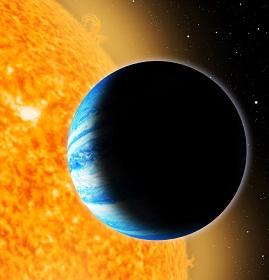Using AI to control energy for indoor agriculture
30 September 2024
Published online 20 December 2010

A Qatari team of astronomers, working with peers from the United States and the United Kingdom, discovered a new planet rotating a distant star. The planet, a gas giant roughly 20% larger than Jupiter, was named Qatar-1b.
"[This discovery] will definitely strengthen the relationship between Arab scientists and their Western counterparts. Science collaborations don't have any boundaries," said Khalid Al Subai an astronomer at Qatar Foundation for Education, Science and Community Development who leads the Qatar exoplanet survey.
The discovery is the result of a one-year-old collaboration between Al Subai Project, a Qatar Foundation project, and the Harvard-Smithsonian Center for Astrophysics (CfA) in the US.
"The discovery of Qatar-1b is a wonderful example of how science and modern communications can erase international borders and time zones. No one owns the stars. We can all be inspired by the discovery of distant worlds," said CfA team member David Latham in a press release.
The team used wide-angle cameras to photograph a large number of stars at regular intervals. The pictures taken on clear, starlit nights since early 2010 were sent to collaborating astronomers at St. Andrews and Leicester Universities in the UK, as well as to astronomers in Qatar for analysis.
The team measured the brightness of the stars and searched for the telltale 'winking' stars which are caused by the sudden blocking of starlight when one of its orbiting planets passes our line of sight.
"However such light reduction is so tiny that the human eye cannot detect it. There are also stars that mimic this signal for one reason or another," explains Al Subai. "Through the process of filtering, we can reduce the number of candidate stars that need follow up spectroscopy with big telescopes."
Al Subai and the CfA team then closely studied these stars with the 60-inch-diameter telescope at the Smithsonian's Whipple Observatory in Arizona, United States. After one year of observing the most promising candidate stars, the team was able to locate the new planet.
The new planet
The gas giant Qatar-1b orbits a star 550 light years from Earth. The planet's trajectory is only 3.5 million kilometers, giving the surface temperature to be a scorching 1,100°C.
Qatar-1b does a complete rotation around its star in 34 hours, making its year shorter than a day and half on Earth. The planet also rotates around itself in 34 hours, making its day as long as its year.
Al Subai is hopeful that Qatar Foundation's collaboration with CfA will yield Qatar's second planet discovery in the next few months. "We will also collaborate with Harvard on the origin [research division] to study these planets we discovered if they have life in any form."
Al Subai hopes his team's discoveries spur interest in astronomy in the region. "The Arab world is in unique location in the world," he stressed. He hopes to make use of this by building more observation stations across the region.
doi:10.1038/nmiddleeast.2010.235
Stay connected: